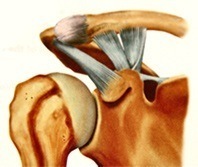
The acromioclavicular joint, AC joint is the articulation between the medial end of the acromion and the distal (lateral) end of the clavicle. The AC joint is located above the glenohumeral joint (true shoulder joint). Unlike the shoulder joint, the AC joint is small and has a limited range of motion and function. However, it is a critical structure as it is the main connection between the arm and the axial skeleton. The entire upper extremity “hangs” from the AC joint which is why the coracoclavicular ligaments are also called the suspensory ligament. The AC joint capsule, which is a thick ligament that encircles the joint is the primary stabilizer of the AC joint. When the joint is injured these are the first ligaments to be injured.
Secondary support to the AC joint comes from the coracoclavicular ligament. This is a short strong ligament that connects the clavicle to the scapula and prevents downward movement of the scapula. It s has two separate components, the conoid and the trapezoid.
What is an AC Joint Separation?
A complete AC joint separation requires ruptures of both the acromioclavicular as well as the coracoclavicular ligaments. Falling from a height onto the “point” of the shoulder puts a large downward force on the scapula and it literally rips off of the clavicle.
A complete AC joint separation creates a deformity. The protruding bump is the edge of the clavicle. While it seems obvious that the problem is the protruding bone which needs to be pushed back down, the solution actually requires just the opposite! The scapula needs to be pushed back up to meet the clavicle and supported there with adequate fixation. The video demonstrates that reducing the joint requires pushing the scapula “up” to the clavicle, not the other way around:
Correct mechanism of injury
Incorrect mechanism of injury
Clinical demonstration of the mechanism of injury
This video shows a patient with a severe chronic AC joint dislocation. In this video the deformity is being corrected by pushing UP on the elbow, not pushing down on the clavicle. This demonstration emphasizes and underscores the point that the joint dislocates when the scapula is pushed down and restoring a normal joint requires pushing it back UP. While the clavicle is prominent after a dislocation is actually not “sticking up”. Its the shoulder that has dropped away!
The more severe the injury the more the joint is disrupted.




